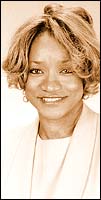


|

Director, NAACP Western Region
By Warren Pagliaro

s one of the guests at the NAACP's 29th annual Image Awards looked around the Pasadena Civic Ballroom, appreciating the abundance of talent and influence around him, he observed, "Things have really changed. You can see it here, you can see it in the people. This is a new NAACP.”
Of that there can be little doubt. Just a few years ago, the National Association for the Advancement of Colored People was awash in internal strife, financial crises and varying degrees of scandal. Then, in ways both sweeping and subtle, the changes began. Kweisi Mfume voluntarily relinquished his seat as U.S. congressman from Maryland and also stepped down as chairman of the Congressional Black Caucus to become NAACP national president. The association was reorganized and restructured, new policies implemented and new people brought on board or moved to positions where their talents could be best put to use.
Today, with the debate over Affirmative Action still raging, race relations a top priority for President Clinton's final term in office and issues affecting minorities very much in the minds and mouths of millions of Americans, the now-vibrant association's role is increasingly important and relevant. Indeed, many civil rights authorities say the organization's influence is greater today than it has been at any time since the civil rights movement of the 1960s.
Although many had part in this comeback, many within the NAACP point to a woman who went from energetic volunteer to become, at that most critical juncture for the organization, one of the NAACP's most dynamic regional directors: Ernestine Barlow Peters.
"When you talk about credit where credit is due," says veteran NAACP official Jeanetta Williams, "you are definitely talking about Ernestine. She is 100%-plus. And I know the NAACP has always been the important thing for her; her work has never been about herself but about this organization. She believes in it and she's seen it work.”
The NAACP
Founded in 1909 by American citizens, both black and white, the NAACP has suffered through many uphill battles. Some 89 years ago, its primary order of business was preventing organized violence against African-Americans and, obtaining the passage and enforcement of anti-lynching laws. In the years which ensued, up through and into World War II, the NAACP shifted its focus to seeking equal rights in the U.S. military and fair job opportunities for civilians.
By the 1950s, the NAACP was plowing important judicial ground, including the landmark Supreme Court decision of Brown v. Board of Education of Topeka which held public school segregation unconstitutional. Later, NAACP members were instrumental in obtaining legislation mandating equal voting rights.
The organization's history features many great names in the struggle to see all Americans treated equally -- people who laid the foundation for the sweeping changes which millions now take for granted. "The saying goes that you 'stand on the shoulders of those gone before,'" says Jeanetta Williams. "People like Ernestine are a little different, because they are already offering their shoulders to other people."
From her impressive efforts as coordinator for the nationally acclaimed NAACP Image Awards, her creation of the NAACP Affirmative Action and Diversity Career Convention in Los Angeles, now in its 13th year, her early award-winning work as an NAACP volunteer, to the innumerable programs she conceives, oversees or takes on, she has already established a formidable track record in advancing human rights for minority Americans. And all of this while running two NAACP regional districts, covering some 16 states and two foreign countries -- the largest territory of any regional director.
A leading example of Ernestine's vision becoming reality is the NAACP Affirmative Action and Diversity Career Convention (also known as the NAACP Job Fair). Created in 1987 and first kicked off in Los Angeles, it is a forum where minority job hunters can meet face to face with corporations and shop for new careers.
Sponsored by companies large and small, attendees enter free of charge and meet representatives of more than 90 companies. Job seekers can talk to staff of the firms in the market for new personnel or just drop off resumes. Some employers, including the Los Angeles Police Department, interview and test applicants on the spot. This year's fair included as participants DreamWorks Studios, Enterprise Rent-A-Car, the Los Angeles Unified School District, Aerospace Corporation, Media One and Sony Pictures.
The program has grown a local, annual event to a national event held twice a year. Thousands have found satisfying jobs owing in no small part to Peters' dedication and vision. According to Lou Shomer, president of Showmex Productions which produces the event, "It is a pleasure working with Ernestine. She's a professional, and she gets things done rather than just talking about them."
Image Awards
The Image Awards began more than three decades ago, when, on October 22, 1962, the newly organized Beverly Hills/Hollywood branch honored Sammy Davis Jr. for his efforts to obtain fair employment for African-American entertainers. He was also acknowledged for his generous financial assistance which helped establish this new NAACP branch — the first to expressly address racism in the entertainment industry. From that first small awards dinner this event has grown to a nationally broadcast network television event, attended by thousands and honoring the accomplishments of black entertainers and those who have contributed significantly to advancing the image of black Americans in the Arts. 1998 honorees included composer and producer Kenneth "Babyface" Edmonds, director Stanley Kramer, actor Dijmon Hounsou, actress Vanessa Williams and U.S. Secretary of Labor Alexis Herman.
Peters' contributions to the Image Awards were considerable from the outset. As a volunteer in 1991, Peters produced, with musician Jeffrey Osborne, a music video which successfully promoted memberships and sponsorships at the National NAACP convention in Texas. In recognition of this and other successful projects and events, Peters was appointed as coordinator of the Image Awards. And with her at the helm, the annual event has become the NAACP's top fundraiser.
"Without Ernestine, it would be impossible to be where we are today with the Image Awards," says John Williams, Vice Chairman of the 1998 NAACP Image Awards and trustee of the NAACP special contribution fund. "She has done an exceptional job in coordinating all of the details of the event from the budget to the pre-show, taping of the event, to the after-show event.
"She works around the clock! Sometimes I get a call from her at 6:00 a.m. ... She's always right there. Right on it. You have to be, to get done all that she does. And she uses her resources well."
According to those who serve under her, this is typical of the dedication she brings to all projects. "I became state president under her a year ago," says Ernest L. Johnson, Louisiana NAACP state president, "and I found her always very industrious, very resourceful. In fact, I could not have accomplished what I have were it not for her." He credits her leadership and direction in helping him win the coveted top state level NAACP award for 1997 — the Kelly Alexander Award — only one year after his election as state president.
The Dream

| ||
 |
Ernestine Peters was a child when she realized segregation was neither natural nor necessary. “I went to an integrated summer camp and it struck me that children like me could interact without any feelings of prejudice on their own,” she said. “Racism is not a natural state of being. I decided I wanted to do what I could to get rid of it.” |
Peters is quick to put in perspective the praise from colleagues. "I wouldn't expect any less of myself," she says. "It is part of what I am and where I am from, and I have never forgotten that."
Where she is from was a deeply segregated Memphis, one of 10 children in a very poor family. There she attended racially divided schools and in many other ways knew what it meant to suffer discrimination. By contrast, she also observed the compassion of those who saw others in terms more meaningful than skin color. As a child, she was taken under the wing of a white pastor and his wife.
She was still a child when she realized segregation was neither natural nor necessary. "It was such a simple thing, but I went to an integrated summer camp and it struck me that children like me could interact without any feelings of prejudice on their own," she said. "Racism is not a natural state of being. I decided I wanted to do what I could to get rid of it."
Though she began helping her local NAACP chapter at an early age, it was later, as a mother, that another pivotal event gave her new focus. Ernestine lost her daughter, Tiffani Oympia, to childhood cancer. "I knew then that I had a mission to reach out and help other people, to touch and help as many other lives as I could," she said. Beyond expanding her work with the NAACP, she began providing extended family outreach counseling to families of children diagnosed with cancer and other catastrophic diseases. And her dedicated community service did not escape the notice of leaders outside the NAACP; she has been recognized and commended by the U.S. Congress, the Governor of California and the City of Los Angeles for her efforts and her example.
When Martin Luther King, Jr. articulated his dream of a "nation... where [people] will not be judged by the color of their skin but by the content of their character," he knew it was ultimately up to the generation which followed him to realize that dream. It is through the dedicated efforts of those like Ernestine Peters that, bit by bit, the dream of a nation where all Americans enjoy true justice and equality is becoming reality.

